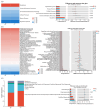Comparative Analysis of Soil Microbial Community Structures in Rhizosphere of Two Texture-Differentiated Lotus Root Varieties
- PMID: 40732146
- PMCID: PMC12299788
- DOI: 10.3390/microorganisms13071637
Comparative Analysis of Soil Microbial Community Structures in Rhizosphere of Two Texture-Differentiated Lotus Root Varieties
Abstract
To investigate the relationship between the rhizosphere microbial community structure and lotus root texture, the biological properties, and the rhizosphere microbial composition of mealy (ML) and crunchy lotus (CL) varieties were all analyzed using traditional and high-throughput sequencing technologies. The results showed that the ML varieties exhibited significantly lower moisture but higher starch contents than those of CL. Meanwhile, the rhizosphere fungal richness of ML was also significantly higher than that of CL. Moreover, the relative abundances of bacterial phyla and genera, such as Nitrospirota, Bacteroidota, Proteobacteria, and Bacillus, alongside fungal phyla and genera, i.e., Ascomycota and Emericellopsis, were enriched in rhizosphere of ML compared to CL. Functional prediction also revealed that elevated nitrogen cycling, polysaccharide degradation and cellulose breakdown functions could be detected in ML, potentially driving starch accumulation and cell wall modification. These results suggest that rhizosphere microbial composition, particularly nitrogen-cycling bacteria and lignocellulose-degrading fungi, may contribute to texture formation between texture-differentiated lotus root varieties.
Keywords: lotus root; microbial compositions; polysaccharides; rhizosphere; texture variation.
Conflict of interest statement
The authors declare no conflicts of interest.
Figures







Similar articles
-
Structure and function of rhizosphere soil microbial communities associated with root rot of Knoxia roxburghii.Front Microbiol. 2024 Jul 18;15:1424633. doi: 10.3389/fmicb.2024.1424633. eCollection 2024. Front Microbiol. 2024. PMID: 39091303 Free PMC article.
-
Effects of saffron-grape intercropping on saffron flower number and rhizosphere microbial community.BMC Microbiol. 2024 Dec 30;24(1):551. doi: 10.1186/s12866-024-03716-4. BMC Microbiol. 2024. PMID: 39736513 Free PMC article.
-
Changes in enzyme activity and microbial community of rhizosphere soil under continuously monocultured Passiflora edulis treatment.PLoS One. 2025 Jul 16;20(7):e0328363. doi: 10.1371/journal.pone.0328363. eCollection 2025. PLoS One. 2025. PMID: 40668837 Free PMC article.
-
Manual lymphatic drainage for lymphedema following breast cancer treatment.Cochrane Database Syst Rev. 2015 May 21;2015(5):CD003475. doi: 10.1002/14651858.CD003475.pub2. Cochrane Database Syst Rev. 2015. PMID: 25994425 Free PMC article.
-
The Black Book of Psychotropic Dosing and Monitoring.Psychopharmacol Bull. 2024 Jul 8;54(3):8-59. Psychopharmacol Bull. 2024. PMID: 38993656 Free PMC article. Review.
References
-
- Xue J., Dong W., Cheng T., Zhou S. Nelumbonaceae: Systematic position and species diversification revealed by the complete chloroplast genome. J. Syst. Evol. 2012;50:477–487. doi: 10.1111/j.1759-6831.2012.00224.x. - DOI
-
- Thanushree M.P., Sudha M.L., Crassina K. Lotus (Nelumbo nucifera) rhizome powder as a novel ingredient in bread sticks: Rheological characteristics and nutrient composition. J. Food Meas. Charact. 2017;11:1795–1803. doi: 10.1007/s11694-017-9561-y. - DOI
-
- Xu S.Y., Shoemaker C.F. Gelatinization properties of Chinese water chestnut starch and lotus root starch. J. Food Sci. 1986;51:445–449. doi: 10.1111/j.1365-2621.1986.tb11151.x. - DOI
-
- Xu Y. Perspectives on the 21st century development of functional foods: Bridging Chinese medicated diet and functional foods. Int. J. Food Sci. Technol. 2001;36:229–242. doi: 10.1046/j.1365-2621.2001.t01-1-00461.x. - DOI
-
- Guo H.B. Cultivation of lotus (Nelumbo nucifera Gaertn. ssp nucifera) and its utilization in China. Genet. Resour. Crop Evol. 2009;56:323–330. doi: 10.1007/s10722-008-9366-2. - DOI
Grants and funding
LinkOut - more resources
Full Text Sources

